Integrated Drought Monitoring and Evaluation through Multi-Sensor Satellite-Based Statistical Simulation
Abstract
1. Introduction
2. Materials and Methods
2.1. Multi-Sensor Drought Indices
2.1.1. Standardized Precipitation Index (SPI)
2.1.2. Agricultural Dry Condition Index (ADCI)
2.1.3. Water Budget-Based Drought Index (WBDI)
2.2. Study Area and Remote Sensing Data
2.3. Integrated Drought Monitoring with Multi-Sensor Based Statistical Simulations
3. Results
3.1. Drought Impact Assessment and Drought Monitoring
3.2. Drought Transition Evaluation by Statistical Simulations
4. Discussion and Conclusions
Author Contributions
Funding
Conflicts of Interest
References
- Zarafshani, K.; Sharafi, L.; Azadi, H.; Van Passel, S. Vulnerability Assessment Models to Drought: Toward a Conceptual Framework. Sustainability 2016, 8, 588. [Google Scholar] [CrossRef]
- Kim, J.S.; Seo, G.S.; Jang, H.W.; Lee, J.H. Correlation analysis between Korean spring drought and large-scale teleconnection patterns for drought forecasting. KSCE J. Civ. Eng. 2017, 21, 458–466. [Google Scholar] [CrossRef]
- Yue, Y.; Shen, S.; Wang, Q. Trend and variability in droughts in Northeast China based on the reconnaissance drought index. Water 2018, 10, 318. [Google Scholar] [CrossRef]
- Qaiser, G.; Tariq, S.; Adnan, S.; Latif, M. Evaluation of a composite drought index to identify seasonal drought and its associated atmospheric dynamics in Northern Punjab, Pakistan. J. Arid Environ. 2021, 185, 104332. [Google Scholar] [CrossRef]
- Cong, D.; Zhao, S.; Chen, C.; Duan, Z. Characterization of droughts during 2001–2014 based on remote sensing: A case study of Northeast China. Ecol. Inf. 2017, 39, 56–67. [Google Scholar] [CrossRef]
- Park, S.Y.; Sur, C.; Kim, J.S.; Lee, J.H. Evaluation of multi-sensor satellite data for monitoring different drought impacts. Stoch. Environ. Res. Risk Assess. 2018, 32, 2551–2563. [Google Scholar] [CrossRef]
- Sur, C.; Park, S.Y.; Kim, T.W.; Lee, J.H. Remote sensing-based agricultural drought monitoring using hydrometeorological variables. KSCE J. Civ. Eng. 2019, 23, 5244–5256. [Google Scholar] [CrossRef]
- Abuzar, M.K.; Shafiq, M.; Mahmood, S.A.; Irfan, M.; Khalil, T.; Khubaib, N. Drought risk assessment in the khushab region of Pakistan using satellite remote sensing and geospatial methods. Int. J. Econ. Environ. Geol. 2019, 10, 48–56. [Google Scholar] [CrossRef]
- Zhong, R.; Chen, X.; Lai, C.; Wang, Z.; Lian, Y.; Yu, H.; Wu, X. Drought monitoring utility of satellite-based precipitation products across mainland China. J. Hydrol. 2019, 568, 343–359. [Google Scholar] [CrossRef]
- Carlson, T.N.; Gillies, R.R.; Perry, E.M. A method to make use of thermal infrared temperatureand NDVI measurements to infer surface soil water content and fractional vegetation cover. Remote Sens. Rev. 1994, 9, 161–173. [Google Scholar] [CrossRef]
- Tadesse, T.; Demisse, G.B.; Zaitchik, B.; Dinku, T. Satellite-based hybrid drought monitoring tool for prediction of vegetation condition in Eastern Africa: A case study for Ethiopia. Water Resour. Res. 2014, 50, 2176–2190. [Google Scholar] [CrossRef]
- Enenkel, M.; Steiner, C.; Mistelbauer, T.; Dorigo, W.; Wagner, W.; See, L. A combined satellite-derived drought indicator to support humanitarian aid organizations. Rem. Sens. 2016, 8, 340. [Google Scholar] [CrossRef]
- Wang, J.; Xu, X.; Ding, S.; Zeng, J.; Spurr, R.; Liu, X.; Chance, K.; Mishchenko, M. A numerical testbed for remote sensing of aerosols, and its demonstration for evaluating retrieval synergy from a geostationary satellite constellation of GEO-CAPE and GOES-R. J. Quant. Spectrosc. Radiat. Transfer. 2014, 146, 510–528. [Google Scholar] [CrossRef]
- Wilhite, D.A. Drought Monitoring and Early Warning: Concepts, Progress and Future Challenges; World Meteorological Organization: Geneva, Switzerland, 2006; p. 1006. [Google Scholar]
- Huang, S.; Huang, Q.; Leng, G.; Liu, S. A nonparametric multivariate standardized drought index for characterizing socioeconomic drought: A case study in the Heihe River Basin. J. Hydrol. 2016, 542, 875–883. [Google Scholar] [CrossRef]
- Wu, Z.; Mao, Y.; Li, X.; Lu, G.; Lin, Q.; Xu, H. Exploring spatiotemporal relationships among meteorological, agricultural, and hydrological droughts in Southwest China. Stoch Environ. Res. Risk Assess. 2016, 30, 1033–1044. [Google Scholar] [CrossRef]
- Sur, C.; Park, S.Y.; Kim, J.S.; Lee, J.H. Prognostic and diagnostic assessment of hydrological drought using water and energy budget-based indices. J. Hydrol. 2020, 591, 125549. [Google Scholar] [CrossRef]
- Guo, Y.; Huang, S.; Huang, Q.; Wang, H.; Fang, W.; Yang, Y.; Wang, L. Assessing socioeconomic drought based on an improved multivariate standardized reliability and resilience index. J. Hydrol. 2019, 568, 904–918. [Google Scholar] [CrossRef]
- McKee, T.B.; Doesken, N.J.; Kleist, J. The relationship of drought frequency and duration to time scales. In Proceedings of the 8th Conference on Applied Climatology, Anaheim, CA, USA, 17–22 January 1993; Volume 17, pp. 179–183. [Google Scholar]
- Shukla, S.; Wood, A.W. Use of a standardized runoff index for characterizing hydrologic drought. Geophys. Res. Lett. 2008, 35, 1100. [Google Scholar] [CrossRef]
- Hayes, M.; Svoboda, M.; Wall, N.; Widhalm, M. The Lincoln declaration on drought indices: Universal meteorological drought index recommended. Bull. Am. Meteorol. Soc. 2011, 92, 485–488. [Google Scholar] [CrossRef]
- Hao, Z.; AghaKouchak, A. A nonparametric multivariate multi-index drought monitoring framework. J. Hydrometeor. 2014, 15, 89–101. [Google Scholar] [CrossRef]
- Cunha, A.P.M.; Alvalá, R.C.; Nobre, C.A.; Carvalho, M. A Monitoring vegetative drought dynamics in the Brazilian semiarid region. Agric. Meteorol. 2015, 2014, 494–505. [Google Scholar] [CrossRef]
- Sur, C.; Hur, J.; Kim, K.; Choi, W.; Choi, M. An evaluation of satellite-based drought indices on a regional scale. Int. J. Remote Sens. 2015, 36, 5593–5612. [Google Scholar] [CrossRef]
- Li, J.; Zhou, S.; Hu, R. Hydrological drought class transition using SPI and SRI time series by loglinear regression. Water Resour. Manage. 2016, 30, 669–684. [Google Scholar] [CrossRef]
- Palmer, W. Meteorological Drought, Weather Bureau Research Paper 45; U.S. Weather Bureau: Washington, DC, USA, 1965; p. 58.
- Zhang, A.; Jia, G. Monitoring meteorological drought in semiarid regions using multi-sensor microwave remote sensing data. Remote Sens. Environ. 2013, 134, 12–23. [Google Scholar] [CrossRef]
- Zhang, X.; Chen, N.; Li, J.; Chen, Z.; Niyogi, D. Multi-sensor integrated framework and index for agricultural drought monitoring. Remote Sens. Environ. 2017, 188, 141–163. [Google Scholar] [CrossRef]
- Kogan, F.N. Application of vegetation index and brightness temperature for drought detection. Adv. Space Res. 1995, 15, 91–100. [Google Scholar] [CrossRef]
- Kogan, F.N. Operational space technology for global vegetation assessment. Bull. Am. Meteorol. Soc. 2001, 82, 1949–1964. [Google Scholar] [CrossRef]
- Oki, T.; Kanae, S. Global hydrological cycles and world water resources. Science 2006, 313, 1068–1072. [Google Scholar] [CrossRef]
- Huffman, G.J.; Adler, R.F.; Bolvin, D.T.; Gu, G.; Nelkin, E.J.; Bowman, K.P.; Hong, Y.; Stocker, E.F.; Wolff, D.B. The TRMM Multi-Satellite Precipitation Analysis: Quasi-Global, Multi-Year, Combined-Sensor Precipitation Estimates at Fine Scale. J. Hydrometeor. 2007, 8, 38–55. [Google Scholar] [CrossRef]
- McKee, T.B. Drought monitoring with multiple time scales. In Proceedings of the 9th Conference, Applied Climatology, Dallas, TX, USA, 15–20 January 1995; pp. 233–236. [Google Scholar]
- Hao, Z.; AghaKouchak, A. Multivariate Standarized Drought Index: A prametric multi-index model. Adv. Water Resour. 2013, 57, 12–18. [Google Scholar] [CrossRef]
- Ma, Y.Y.; Zhu, L.P. A Review on Dimension Reduction. Int. Stat. Rev. 2012, 81, 134–150. [Google Scholar] [CrossRef] [PubMed]
- Jolliffe, I.T. Principal Component Analysis, 2nd ed.; Springer Science Business Media: Berlin, Germany, 2002. [Google Scholar]
- Oba, S.; Sato, M.A.; Takemasa, I.; Monden, M.; Matsubara, K.I.; Ishii, S. A Bayesian missing value estimation method for gene expression profile data. Bioinformatics 2003, 19, 2088–2096. [Google Scholar] [CrossRef] [PubMed]
- Lai, W.Y.; Kuok, K.K. A Study on Bayesian Principal Component Analysis for Addressing Missing Rainfall Data. Water Resour. Manag. 2019, 33, 2615–2628. [Google Scholar] [CrossRef]
- Lee, T. Climate change inspector with intentionally biased bootstrapping (CCIIBB ver. 1.0)–methodology development. Geosci. Model. Dev. 2017, 10, 525–536. [Google Scholar] [CrossRef]
- Bouveyron, C.; Latouche, P.; Mattei, P.A. Exact dimensinality selection for Bayesian PCA. Scand. J. Statist. 2020, 47, 196–211. [Google Scholar] [CrossRef]
- Heng, C.; Lee, T.; Kim, J.-S.; Xiong, L. Influence analysis of central and Eastern Pacific El Niños to seasonal rainfall patterns over China using the intentional statistical simulations. Atmos. Res. 2020, 233, 104706. [Google Scholar] [CrossRef]
- Zelinka, I. SOMA—self-organizing migrating algorithm. In New Optimization Techniques in Engineering; Springer: Berlin/Heidelberg, Germany, 2004; pp. 167–217. [Google Scholar]
- Baek, S.G.; Jang, H.W.; Kim, J.S.; Lee, J.H. Agricultural drought monitoring using the satellite-based vegetation index, Korea Water Resources Association. J. Korea Water Resour. Assoc. 2016, 49, 305–314. (In Korean) [Google Scholar] [CrossRef]
- Lee, J.H.; Jang, H.W. Comparison on Characteristics and Historical Drought Events of summer drought in 2014. Korea Disaster Prevention Association. J. Disaster Prev. 2014, 16, 46–56. (In Korean) [Google Scholar]
- Ministry of Land, Infrastructure and Transport (MLIT). 2015 Drought Impact Investigation Report; Korea Ministry of Land, Infrastructure and Transport (MLIT): Sejong City, Korea, 2015. (In Korean) [Google Scholar]
- Bae, H.; Ji, H.; Lim, Y. Characteristics of drought propagation in South Korea: Relationship between meteorological, agricultural, and hydrological droughts. Nat. Hazards. 2019, 99, 1–16. [Google Scholar] [CrossRef]
- Hong, I.P.; Lee, J.H.; Cho, H.S. National drought management framework for drought preparedness in Korea (lessons from the 2014–2015 drought). Water Policy 2016, 18, 89–106. [Google Scholar] [CrossRef]
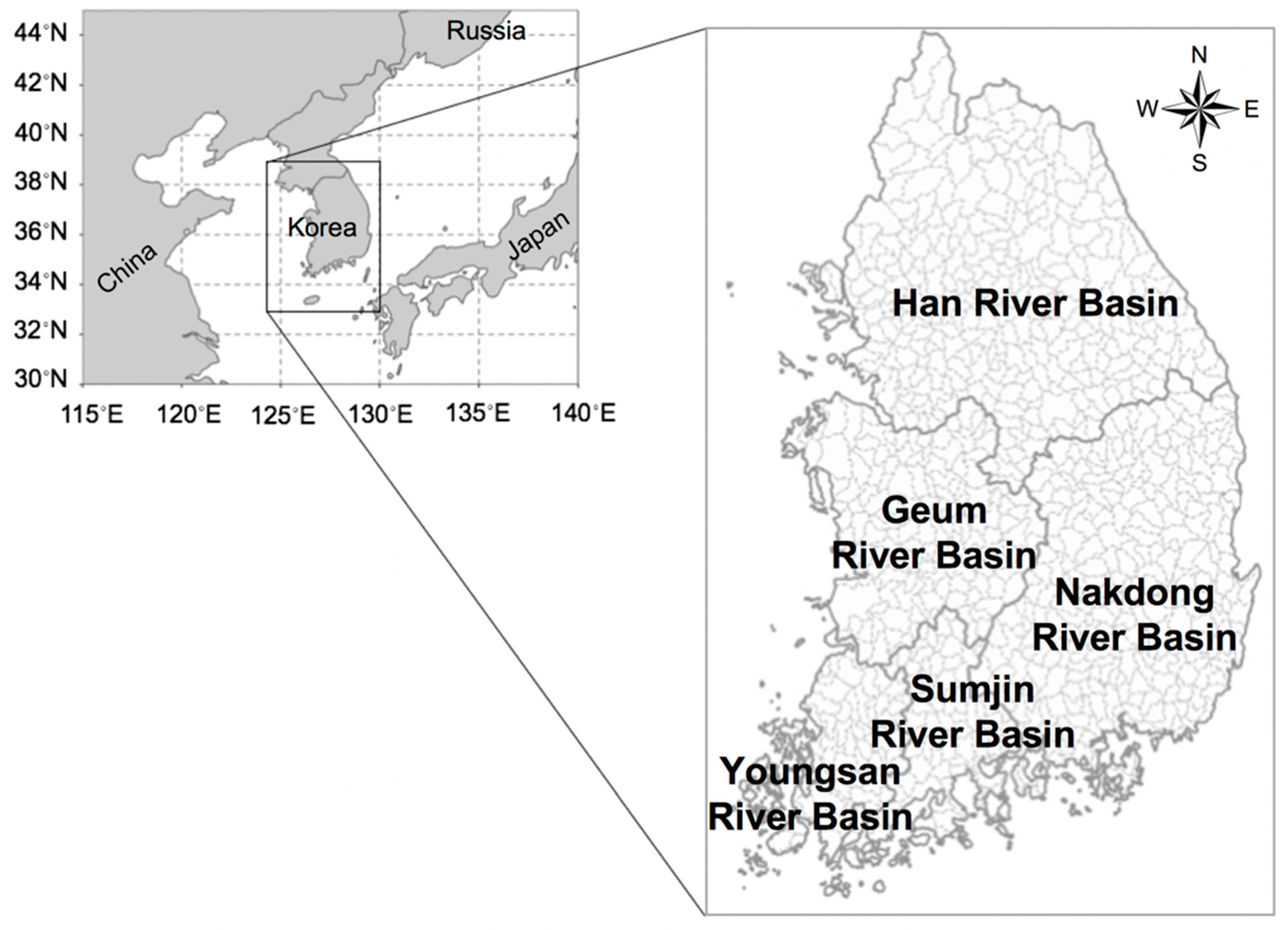
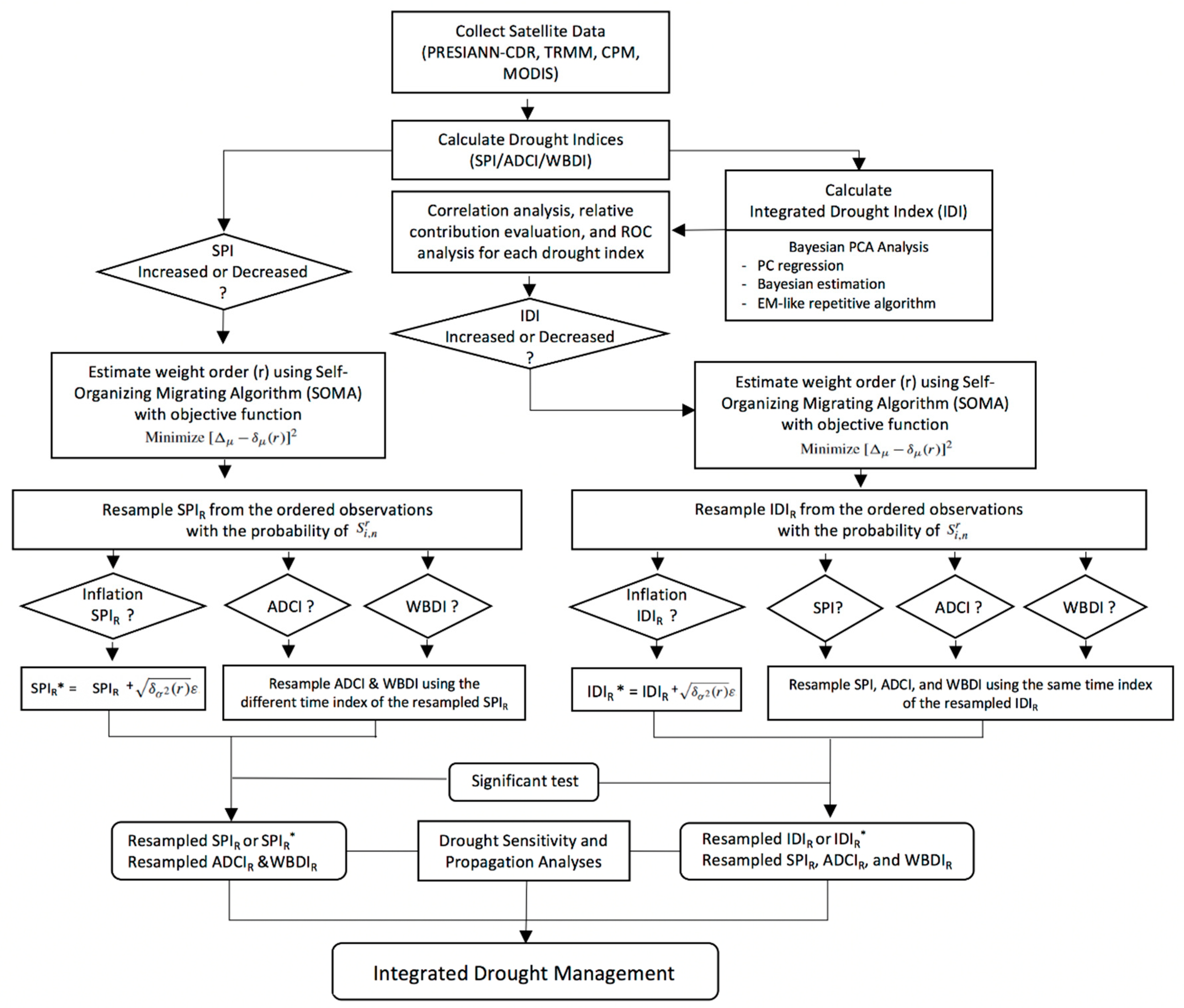
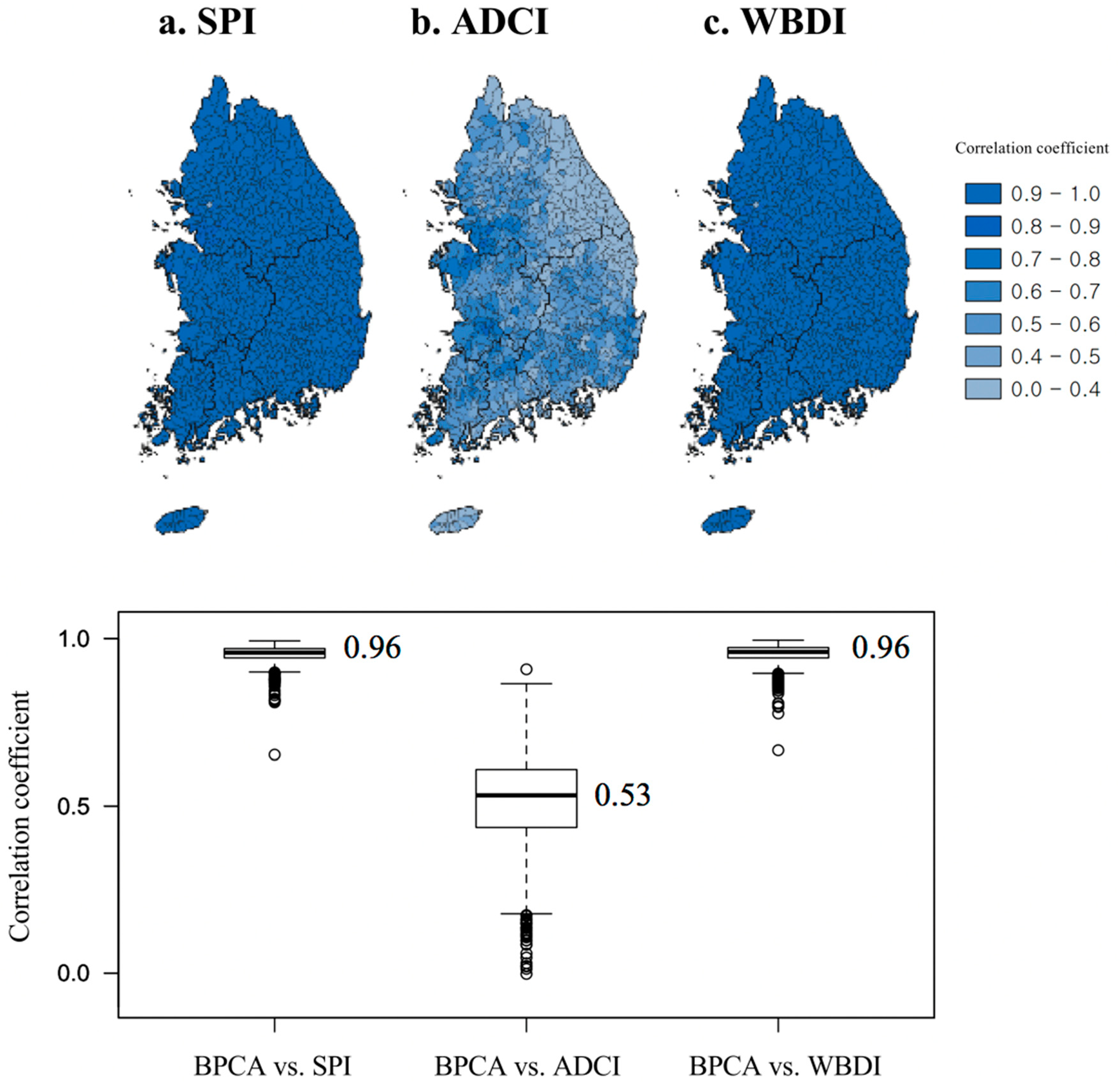
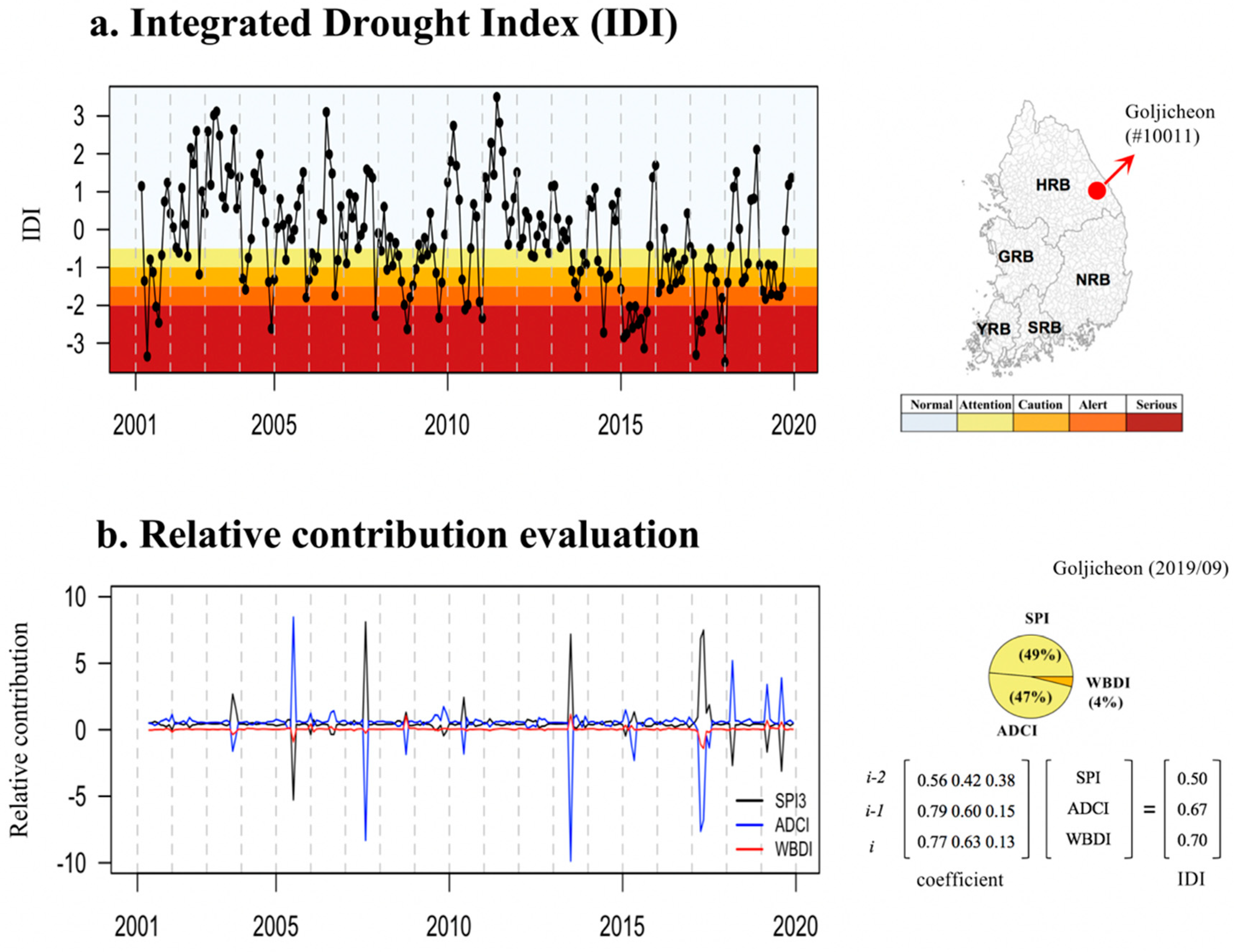
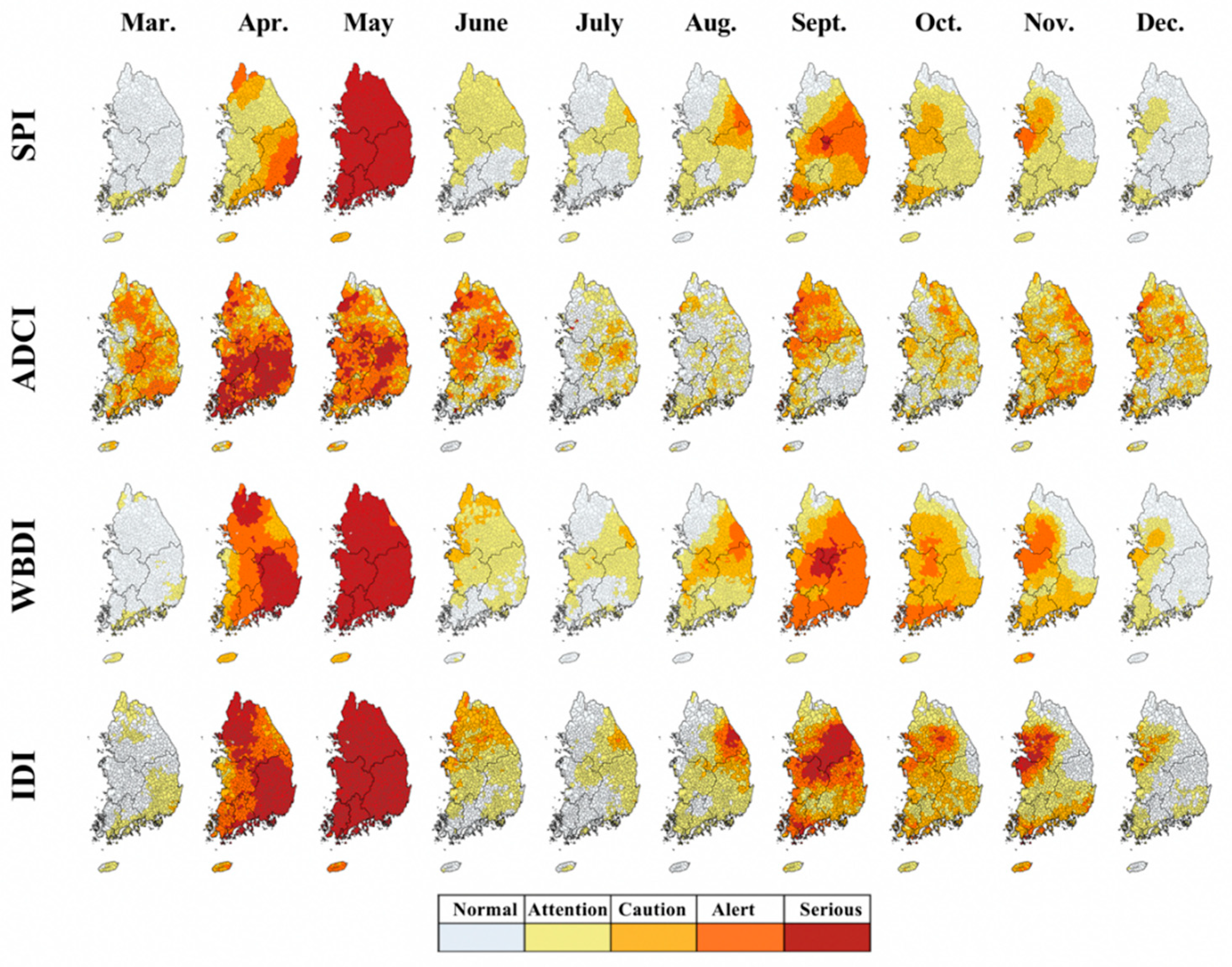
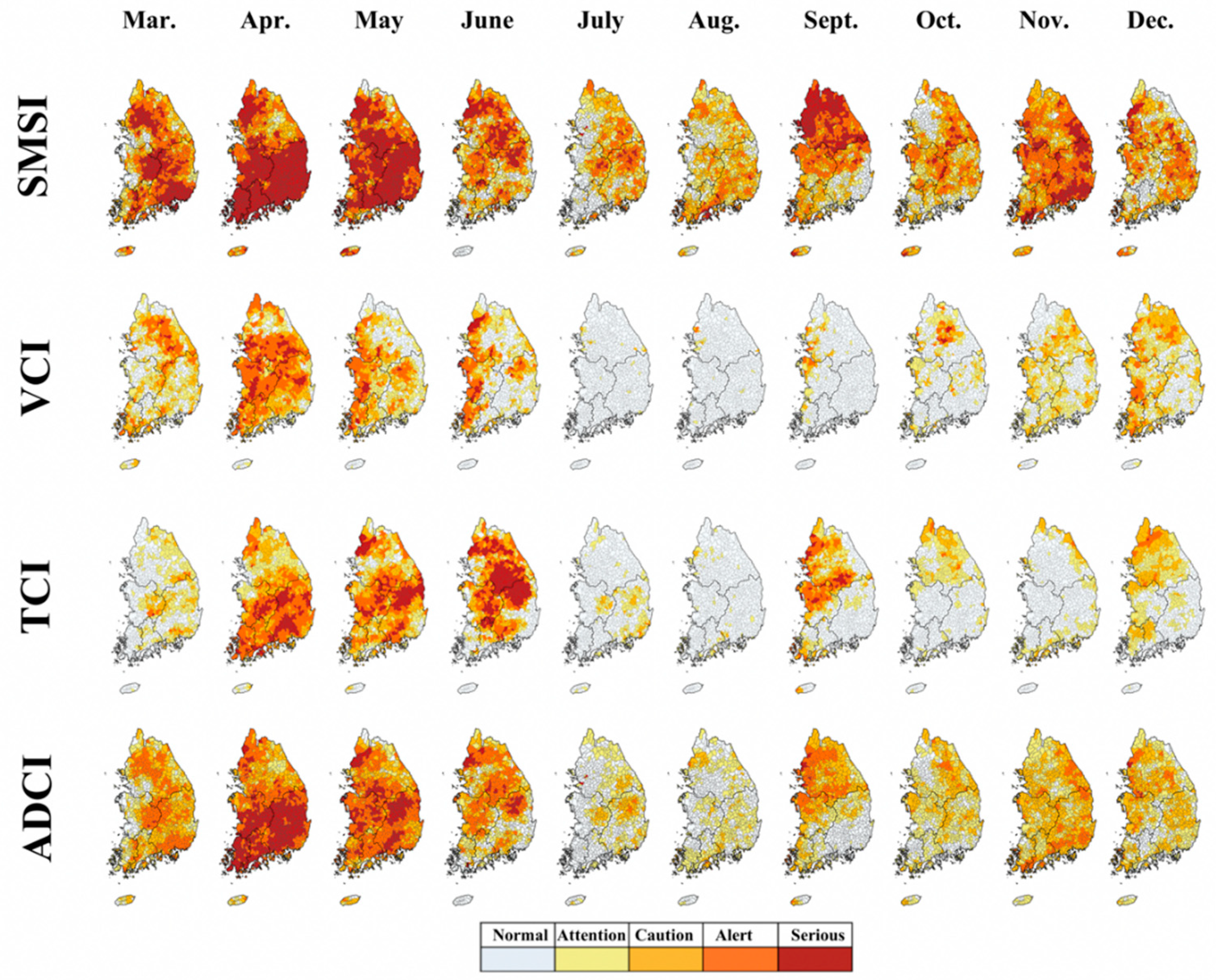

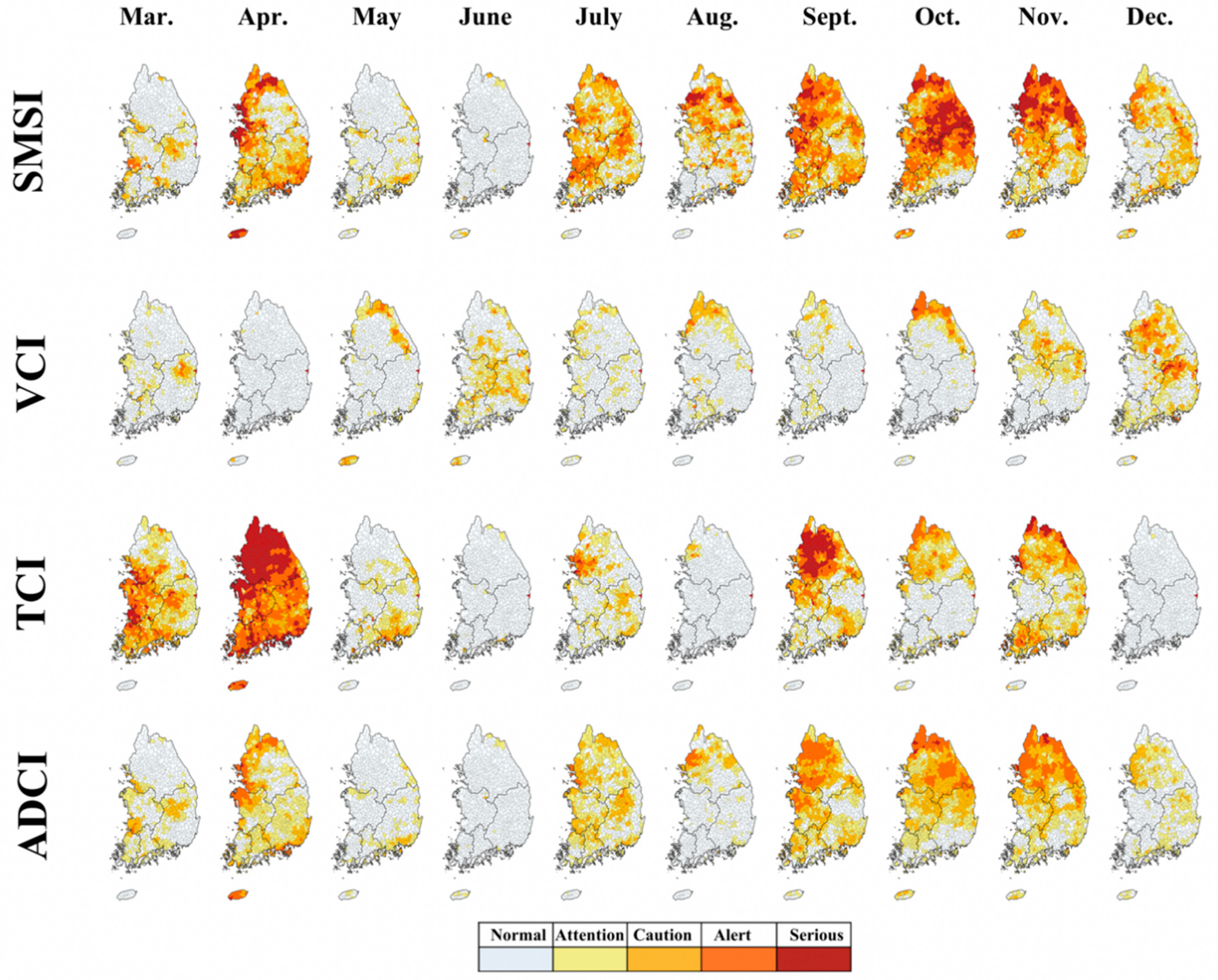
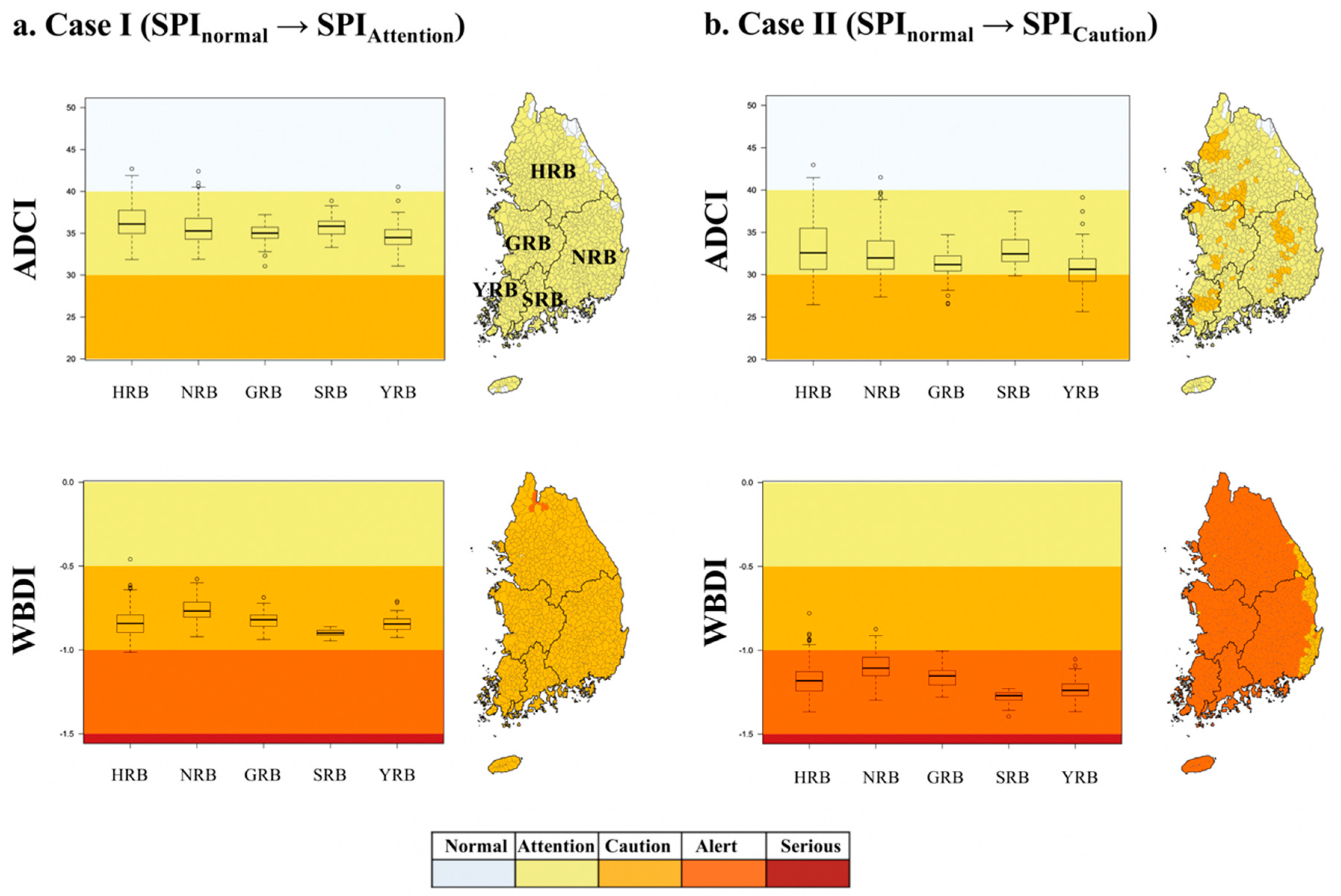
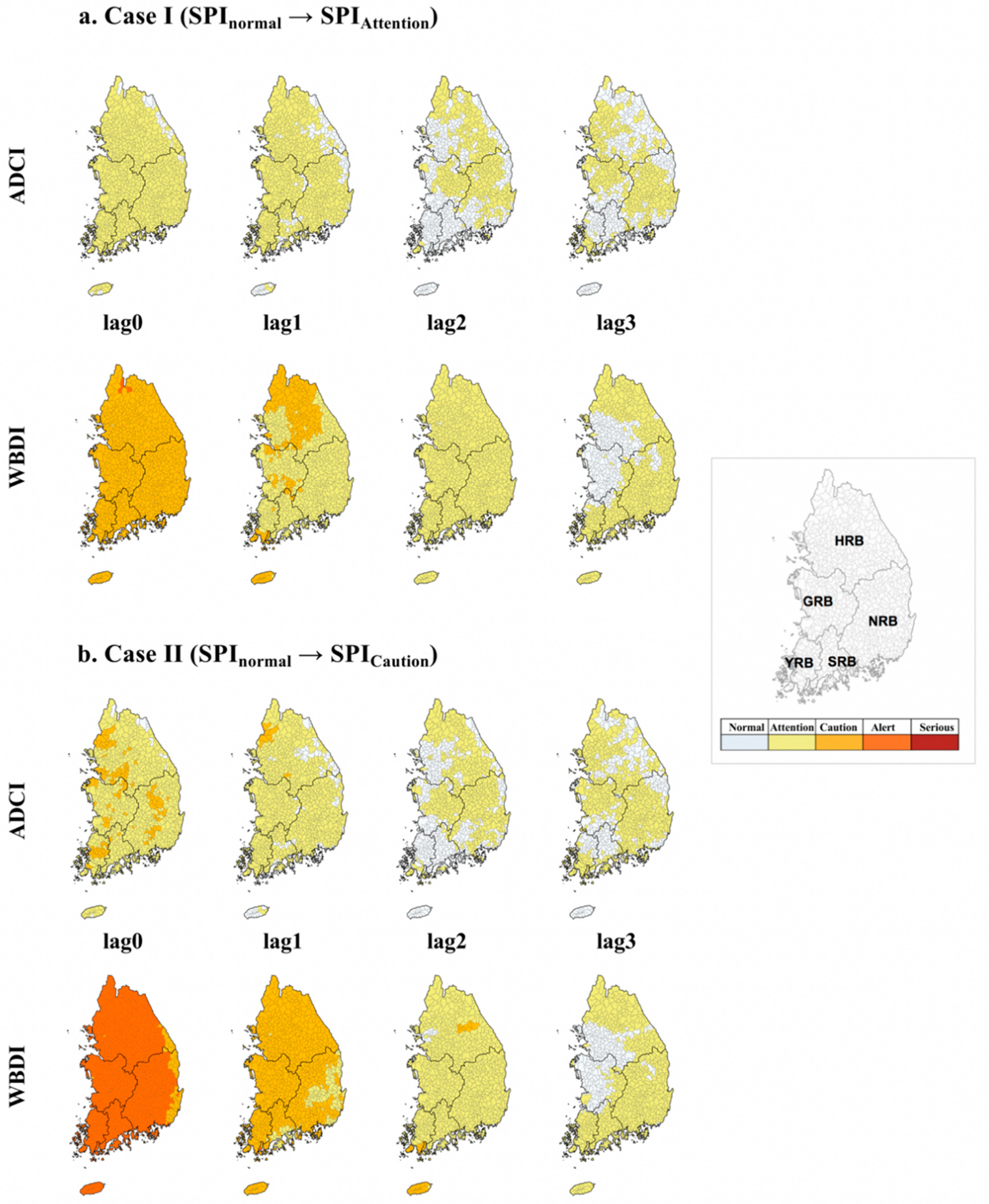
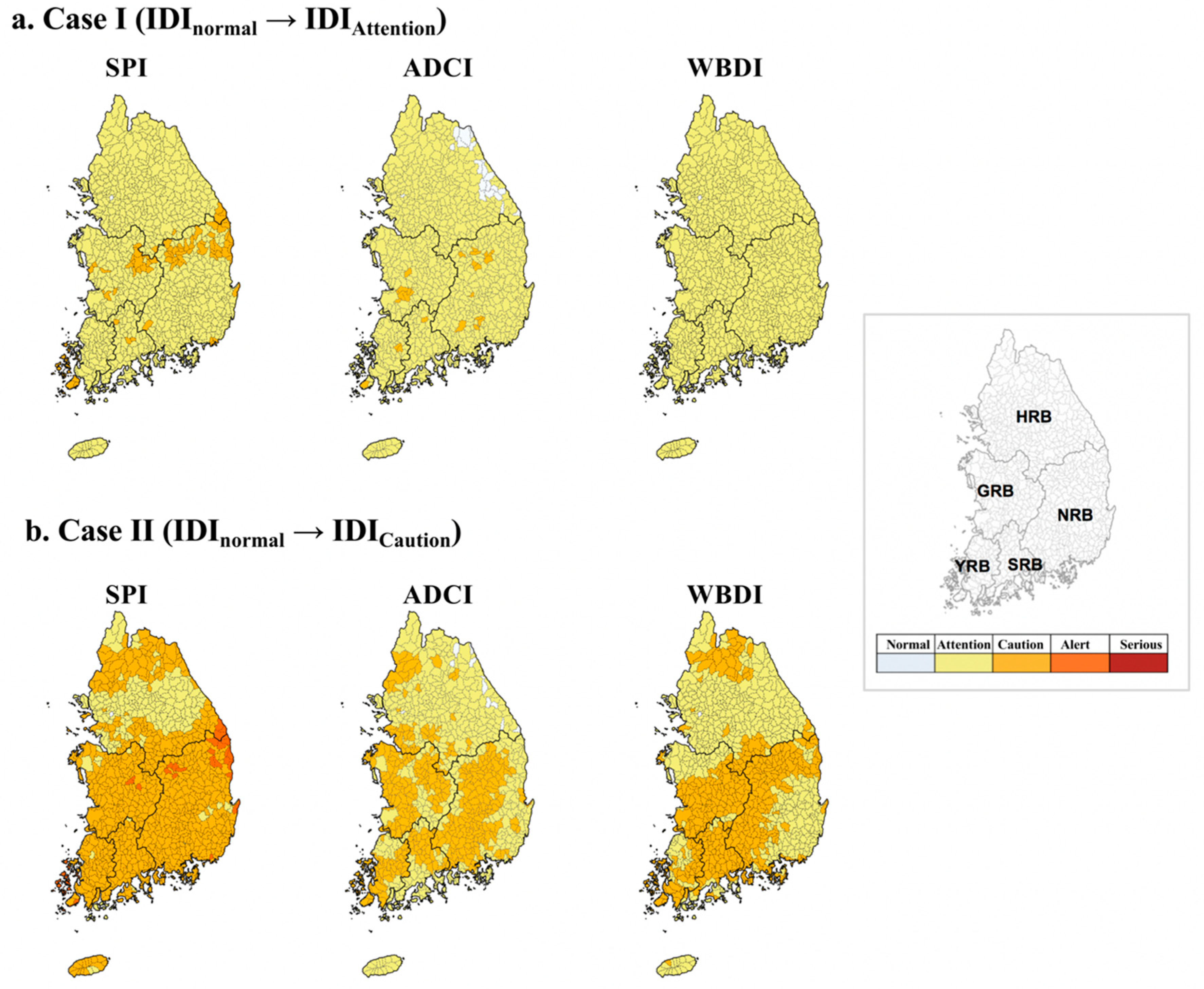
| Product | Resolution | Data Period | ||
|---|---|---|---|---|
| MODIS | MOD11A1 | Land Surface Temperature | 1 km, daily | 2001–2019 |
| MOD13A3 | Vegetation Indices | 1 km, monthly | ||
| MOD16A2 | Evapotranspiration | 0.5 km, 8 days | ||
| MCD43B2 | Albedo | 1 km, 8 days | ||
| PERSIANN-CDR | PERSIANN-CDR | Precipitation | 25°, daily | 1983–1997 |
| TRMM | TRMM3B42 | Precipitation | 25°, 3 h | 1998–2014 |
| GPM | GPM IMERG | Precipitation | 10°, 30 min | 2015–2019 |
| Drought Condition | SPI | ADCI | WBDI | RSIDI |
|---|---|---|---|---|
| Normal | >0 | >40 | >0 | >0 |
| Attention | −1.0–0 | 30–40 | 0–−0.5 | −1.0–0 |
| Caution | −1.0–−1.5 | 20–30 | −0.5–−1.0 | −1.0–−1.5 |
| Alert | −1.5–−2.0 | 10–20 | −1.0–−1.5 | −1.5–−2.0 |
| Serious | <−2.0 | 0~10 | <−1.5 | <−2.0 |
Publisher’s Note: MDPI stays neutral with regard to jurisdictional claims in published maps and institutional affiliations. |
© 2021 by the authors. Licensee MDPI, Basel, Switzerland. This article is an open access article distributed under the terms and conditions of the Creative Commons Attribution (CC BY) license (http://creativecommons.org/licenses/by/4.0/).
Share and Cite
Kim, J.-S.; Park, S.-Y.; Lee, J.-H.; Chen, J.; Chen, S.; Kim, T.-W. Integrated Drought Monitoring and Evaluation through Multi-Sensor Satellite-Based Statistical Simulation. Remote Sens. 2021, 13, 272. https://doi.org/10.3390/rs13020272
Kim J-S, Park S-Y, Lee J-H, Chen J, Chen S, Kim T-W. Integrated Drought Monitoring and Evaluation through Multi-Sensor Satellite-Based Statistical Simulation. Remote Sensing. 2021; 13(2):272. https://doi.org/10.3390/rs13020272
Chicago/Turabian StyleKim, Jong-Suk, Seo-Yeon Park, Joo-Heon Lee, Jie Chen, Si Chen, and Tae-Woong Kim. 2021. "Integrated Drought Monitoring and Evaluation through Multi-Sensor Satellite-Based Statistical Simulation" Remote Sensing 13, no. 2: 272. https://doi.org/10.3390/rs13020272
APA StyleKim, J.-S., Park, S.-Y., Lee, J.-H., Chen, J., Chen, S., & Kim, T.-W. (2021). Integrated Drought Monitoring and Evaluation through Multi-Sensor Satellite-Based Statistical Simulation. Remote Sensing, 13(2), 272. https://doi.org/10.3390/rs13020272










